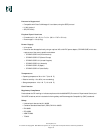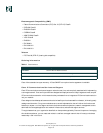
Cisco Systems, Inc.
All contents are Copyright © 1992–2002 Cisco Systems, Inc. All rights reserved. Important Notices and Privacy Statement.
Page 2 of 5
• “Menu” key—This key allows users to quickly access information such as call logs and phone settings.
– The user can retrieve voice-mail messages.
– The user can display missed calls, outgoing calls that have been placed, and incoming calls that have been
received.
– The user can set various preferences such as ring types and display contrast.
• “Hold” key—This lighted key provides the user a red visual indication that they have placed a call on hold.
• A volume-control toggle provides easy decibel-level adjustments of the handset and ringer.
• A hearing-aid-compatible handset (meets American Disabilities Act [ADA] requirements)
• A single-position foot stand provides optimum display viewing and comfortable use of buttons and keys. The
foot stand can be removed to allow wall mounting via mounting holes located on the base of the phone.
• XML Applications can be delivered to the display.
Calling Features
The Cisco IP Phone 7905G is designed to grow with system capabilities. Features will keep pace with new changes
via software updates to the phone’s flash memory. Examples of currently available features include:
• Single Line/Directory Number (DN)
• Calling name and number display
• Call Waiting
• Call Forward
• Call Transfer
• Three-way calling (conference)
• On-hook dialing, Pre-Dialing, and Off-hook dialing
• Redial
• Call hold
• Call monitor (speaker-only, no microphone)
• “Messages” soft key allows access to voice mail messages
• Four Speed dials configurable at the Call Manager
Network Features
• Cisco Discovery Protocol (CDP)
• IEEE 802.1q (VLAN)
• G.711a, G.711u, G.729ab audio-compression coder-decoders (codecs)
• 10BASE-T Ethernet connection via a RJ-45 interface for LAN connectivity
• Software upgrade supported via Trivial File Transfer Protocol (TFTP) server
• Provisioning of network parameters through Dynamic Host Configuration Protocol (DHCP)
• Voice-activity detection, silence suppression, comfort-noise generation, and error concealment







